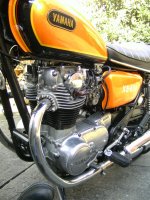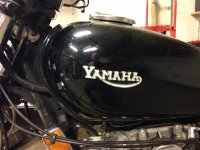Tips and Techniques: Bondo.
This thread is supposed to be a 'How To', so I better start offering up some....
For years, body filler aka Bondo™ had a bad rap as a bunch of garbage that just fell off as soon as you slammed the door shut. There was more than a grain of truth to that, but it wasn't the bondo's fault... it was mainly due to user error. People just didn't use it correctly. Over the years the formula improved and we users got better... today's bondo is a practically foolproof material for mending dings. So... here's some things I've learned...
Safety: If you've never used bondo before, read ALL the precautions on the can... and follow them. You really need to know what you're dealing with. 'Nuff said. At minimum, use a dust mask when sanding bondo.
Surface prep: Some people use bondo over painted metal. I don't and don't recommend you do either. Your best adhesion comes with bare metal. Anything less is iffy in my (experienced) opinion. What I'll do is take the area down to bare metal and then scuff it real good with some 60-80 grit sandpaper. In other words, I'll scratch the hell out of it. I've found it gives the best bond possible. Next I'll wipe the area real good with a rag soaked in lacquer thinner. As with all things in painting, cleanliness is everything.
Mixing and applying: Here, watch this guy.
Here's a little trick I use when I can. Bondo is what's called "photo-chemically reactive." What that means in practical terms is, sunlight will accelerate it's curing. This allows you to mix it slightly weak... a little less hardener and you can double your working time from about 4-5 min. up to about 8-10 min. All you do then is take it out into the sunlight. When the sunlight hits it, it will "kick off" and harden very quickly. And that bring me to a warning... never apply it in direct sunlight. It'll cut your working time in half or more.
Sanding: Once it's cured, start sanding with an aggressive paper. I normally start with 40-60 grit. Use a hard sanding block. I just make 'em out of 1by wood and tape the paper on with Gorilla tape.
With a hard sanding block, It's much easier to shape bondo... and small blocks like these are perfect for something the size of tanks and side covers.
After you get the bondo close, you just switch to finer and finer grits. I usually wind up at about 240 or 320. That's fine enough for the initial primer. If you need to add bondo between sandings, blow the dust off with a blow gun, use a shop vac to suck the dust out of the nooks and cranies, then wipe it down with the lacquer thinner. Apply more bondo and git back to sanding.
As far as knowing when the bondo is shaped right, your fingers will tell you more than your eyeballs. Once trained, you fingers will find dips and imperfections your eyes will never see. And you can practice that anytime just by running your hand over something and comparing what you feel with what you see. Try it.
That's about it for now. Next up, priming and hunting "pinholes."


 from the peanut gallery.
from the peanut gallery.